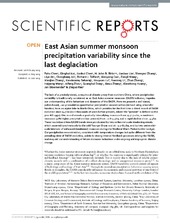| dc.contributor.author | Chen, Fahu | |
| dc.contributor.author | Xu, Qinghai | |
| dc.contributor.author | Chen, Jianhui | |
| dc.contributor.author | Birks, Harry John Betteley | |
| dc.contributor.author | Liu, Jianbao | |
| dc.contributor.author | Zhang, Shengrui | |
| dc.contributor.author | Jin, Liya | |
| dc.contributor.author | An, Chengbang | |
| dc.contributor.author | Telford, Richard | |
| dc.contributor.author | Cao, Xianyong | |
| dc.contributor.author | Wang, Zongli | |
| dc.contributor.author | Zhang, Xiaojian | |
| dc.contributor.author | Selvaraj, Kandasamy | |
| dc.contributor.author | Lu, Houyuan | |
| dc.contributor.author | Li, Yuecong | |
| dc.contributor.author | Zheng, Zhuo | |
| dc.contributor.author | Wang, Haipeng | |
| dc.contributor.author | Zhou, Aifeng | |
| dc.contributor.author | Dong, Guanghui | |
| dc.contributor.author | Zhang, Jiawu | |
| dc.contributor.author | Huang, Xiaozhong | |
| dc.contributor.author | Bloemendal, Jan | |
| dc.contributor.author | Rao, Zhiguo | |
| dc.date.accessioned | 2016-03-04T08:35:51Z | |
| dc.date.available | 2016-03-04T08:35:51Z | |
| dc.date.issued | 2015-06-18 | |
| dc.Published | Scientific Reports 2015, 5:11186 | eng |
| dc.identifier.issn | 2045-2322 | en_US |
| dc.identifier.uri | http://hdl.handle.net/1956/11432 | |
| dc.description.abstract | The lack of a precisely-dated, unequivocal climate proxy from northern China, where precipitation variability is traditionally considered as an East Asian summer monsoon (EASM) indicator, impedes our understanding of the behaviour and dynamics of the EASM. Here we present a well-dated, pollen-based, ~20-yr-resolution quantitative precipitation reconstruction (derived using a transfer function) from an alpine lake in North China, which provides for the first time a direct record of EASM evolution since 14.7 ka (ka = thousands of years before present, where the “present” is defined as the year AD 1950). Our record reveals a gradually intensifying monsoon from 14.7–7.0 ka, a maximum monsoon (30% higher precipitation than present) from ~7.8–5.3 ka, and a rapid decline since ~3.3 ka. These insolation-driven EASM trends were punctuated by two millennial-scale weakening events which occurred synchronously to the cold Younger Dryas and at ~9.5–8.5 ka, and by two centennial-scale intervals of enhanced (weakened) monsoon during the Medieval Warm Period (Little Ice Age). Our precipitation reconstruction, consistent with temperature changes but quite different from the prevailing view of EASM evolution, points to strong internal feedback processes driving the EASM, and may aid our understanding of future monsoon behaviour under ongoing anthropogenic climate change. | en_US |
| dc.language.iso | eng | eng |
| dc.publisher | Nature Publishing Group | en_US |
| dc.rights | Attribution CC BY | eng |
| dc.rights.uri | http://creativecommons.org/licenses/by/4.0/ | eng |
| dc.title | East Asian summer monsoon precipitation variability since the last deglaciation | en_US |
| dc.type | Peer reviewed | |
| dc.type | Journal article | |
| dc.date.updated | 2015-12-30T17:07:56Z | |
| dc.description.version | publishedVersion | en_US |
| dc.rights.holder | Copyright 2015 The Authors | en_US |
| dc.identifier.doi | https://doi.org/10.1038/srep11186 | |
| dc.identifier.cristin | 1261559 | |
| dc.subject.nsi | VDP::Matematikk og naturvitenskap: 400::Geofag: 450::Naturgeografi: 455 | |
| dc.subject.nsi | VDP::Mathematics and natural scienses: 400::Geosciences: 450::Physical geography: 455 | |

